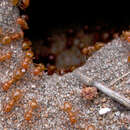en
names in breadcrumbs


Lasius claviger, the smaller yellow ant, is one of 16 described species of the New World lineage known as the citronella ants.Previously considered genus Acanthomyops, the citronella ant lineage is now included in the genus Lasius as the “Claviger group” (Ward 2005).Citronella ants are common throughout most of North America, and distinctive for their bright yellow-orange color, small eyes, and when disturbed, the strong lemon-verbena smell they emit.
Workers of the smaller yellow ant are 3-4 mm in size (distinguishing this species from the larger yellow ant, Lasius interjectus, which is several mm larger).These ants form large colonies under small logs and rocks in moist forests, pastures, fields, and near houses, especially in eastern North America.While their ecology is not well known, they are thought to tend homopterans (aphid and mealybug) that live on roots underground, and feed on the honeydew they produce.Although they spend most of their lifecycle underground, they form mating swarms to establish new colonies, especially mid- to late summer.Because they sometimes swarm near houses, they are considered a nuisance pest.Swarmer ants are winged, about twice as large as worker ants, dark reddish - brown in color and are frequently confused with termites.
(Fisher and Cover 2007; Jacobs 2014; Maxwell 2014; Raczkowski and Luque 2011).
Aus Pensylvanien (Mus. Caes.).